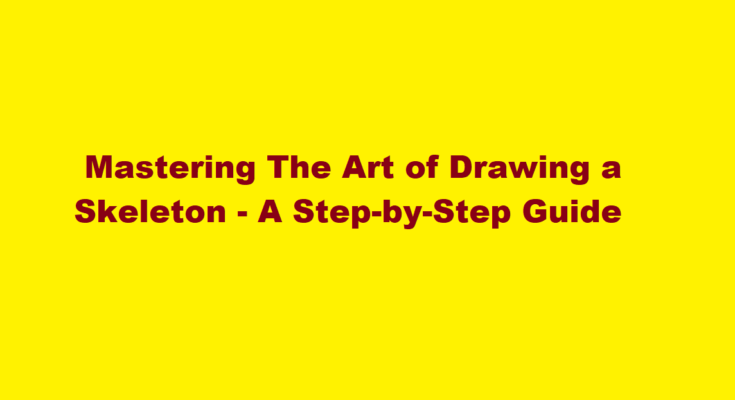Introduction
Drawing a skeleton may seem daunting at first, but with the right techniques and some practice, it can become an accessible and fascinating subject for artists of all levels. A skeleton serves as a fundamental structure for understanding the human body’s proportions and movements, making it an invaluable skill for artists, medical illustrators, and even Halloween enthusiasts. In this article, we will provide you with a step-by-step guide on how to draw a skeleton, ensuring that you gain confidence in capturing the intricate details of the human skeletal system.
Materials Needed
Before you start drawing a skeleton, gather the following materials
1. Sketching paper or drawing pad
2. Pencils of varying hardness (e.g., 2H, HB, 2B, 4B)
3. Erasers (both kneaded and regular)
4. A ruler (for precise measurements)
5. A reference image of a skeleton (online, in a book, or a physical model)
Understand the Basic Anatomy
To draw a skeleton accurately, it’s essential to understand the basic anatomical structure. The human skeleton consists of over 200 bones that can be broadly divided into two parts: the axial skeleton (skull, vertebral column, and ribcage) and the appendicular skeleton (limbs and girdles). Familiarize yourself with these components to grasp their proportions and relationships.
Prepare Your Workspace
Find a quiet, well-lit area to work, free from distractions. Ensure that your drawing paper is clean, your pencils are sharpened, and your erasers are readily accessible. Have your reference image or model within view for easy comparison and inspiration.
Outline the Main Shapes
Begin by drawing the basic shapes of the skeleton. For the skull, start with a circle for the cranium and a rectangular shape for the mandible (lower jaw). Next, sketch a straight vertical line for the vertebral column, which serves as the central axis of the skeleton. Draw the ribcage as an elongated oval shape attached to the top part of the vertebral column.
Add Limbs and Joints
Extend the vertebral column downward to create the sacrum and coccyx. For the arms and legs, draw long, cylindrical shapes for the humerus, radius, ulna, femur, tibia, and fibula. Pay attention to the joints; use small circles to represent the shoulder, elbow, wrist, hip, knee, and ankle joints. The wrist and ankle joints are more complicated, so refer to your reference for guidance.
Refine the Skull
Now, focus on the skull. Draw the eye sockets, nasal cavity, and jawline by following the contours of your reference image. Pay attention to the shape and position of the teeth and the orbits (eye sockets). The reference will help you capture the intricacies of the skull.
Define the Spine and Ribcage
Refine the vertebral column by adding vertebrae, making sure to create a slight curve in the lower back (lumbar region). Draw the rib cage with curved lines to represent individual ribs. Remember that not all ribs are visible, so choose a few to emphasize for a more natural look.
Work on the Limbs
Add more detail to the arms and legs. Create joints at the shoulder, elbow, wrist, hip, knee, and ankle by adding the specific anatomical features of each. Pay attention to the proportions and angles of these bones. Don’t forget to add the hand and foot bones, which are complex but crucial for a realistic skeleton.
Refine and Erase
Go over your entire skeleton, refining lines, adding details, and making corrections as needed. Erase any unnecessary or overlapping lines to create a clean, accurate representation of the skeleton.
Shade and Add Depth
Using your various pencils, shade the skeleton to give it depth. Pay attention to areas that would be naturally darker, such as the eye sockets, the space between the ribs, and the joints. Gradually build up the shading, and use an eraser to create highlights, particularly on the skull and joints.
Final Touches
Review your drawing for any remaining imperfections or inaccuracies. Make any necessary adjustments, and you’re ready to finalise your skeleton drawing.
FREQUENTLY ASKED QUESTIONS
What is a skeleton easy?
At the simplest level, the skeleton is the framework that provides structure to the rest of the body and facilitates movement. It includes over 200 bones, cartilage, and ligaments.
What is a skeleton for Class 7?
The skeletal system functions as the basic framework of a body and the entire body are built around the hard framework of Skeleton. It is the combination of all the bones and tissues associated with cartilages and joints. Almost all the rigid or solid parts of the body are the main components of the skeletal system.
Conclusion
Drawing a skeleton is a challenging but rewarding endeavour for artists interested in anatomy and those looking to enhance their artistic skills. By following these steps and practising regularly, you’ll develop a better understanding of the human skeletal system and improve your ability to depict it accurately. Whether you’re aiming for scientific precision or a spooky Halloween decoration, drawing a skeleton is a valuable skill that will undoubtedly benefit your artistic journey.
Read Also : Crafting The Wheel in Little Alchemy A Guide to Mastering the Art



